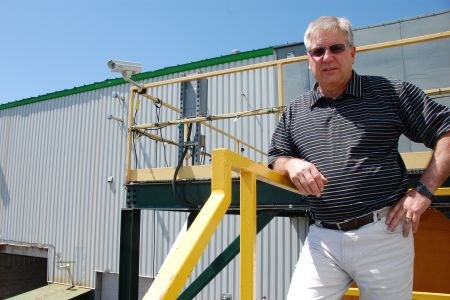A black and white aerial photo in Rod McKay's office at Kenora Forest Products taken in the mid-1920s show stacks of lumber piled so high in the yard that workers scaled catwalks to cross over them.
That was back in the heydays of the area's forestry industry when logs were rafted in large booms around the mill on Keewatin Bay.
There has been a forestry operation on the site for more than a century.
“We've got payroll records going back to the 1880s,” said McKay.
Fast forward to today and the property just off Highway 17 sits empty, save for the processing buildings.
As mill manager at Kenora for almost half of his 35-year forestry career, McKay and his wife, a local teacher, have enjoyed the jet-skiing lifestyle of Lake of the Woods. But it's been difficult to shepherd a darkened sawmill through a three-year shutdown.
“I'd much rather be doing operations,” said McKay.
The industry upheaval in the early 2000s has cost Kenora hundreds of jobs, punctuated by the 2006 shutdown of the Abitibi Consolidated pulp and paper plant.
The slumping U.S. housing market forced Kenora Forest Product's Winnipeg parent company, Prendiville Industries, to mothball it in February 2008 and lay off 105 employees.
In August, the company received a long-awaited Crown wood supply of 101,000 cubic metres from the Kenora Forest management unit to expand its sawmill operation, whenever market conditions improve.
That will be tacked onto its current 258,000 cubic metre wood supply.
McKay said it's tough to predict when the mill will restart given the economic uncertainty south of the border.
“But I think it's going to be a big winner here soon. When the U.S. market turns around there's not going to be enough wood to supply it.”
McKay said U.S. sawmills can easily supply its domestic market during slow periods, but during building booms, Canada contributes about 30 per cent.
Industry forecasts indicate U.S. home construction staying dormant until the spring of 2012.
When Kenora Forest Products was rolling, it produced 80-million board feet annually of building studs.
If a $30-million capital expansion goes off, that could increase to 180-million board feet, allowing the company to make a wider array of dimensional products, including metric lengths, and to manufacture machine-stress-rated lumber (MSR).
“We have most of the financing in place and we're waiting to see what's the best time to move ahead,” said McKay.
Part of the expansion calls for a joint venture pellet plant with another undisclosed partner company.
“We're all excited about the future,” said McKay. “We're all just hunkered down and trying to watch our cash as much as we can so we have the resources to start up again.”
Prendiville is also keen on developing offshore markets in China and Asia, especially areas of Japan devastated by last March's earthquake and tsunami.
“The Canadian-style homes and home-building process that we use is much better for earthquakes than the traditional Japanese stick frame homes. They proved that in the (1995) Kobe earthquake.”
As he waited, McKay decided to run for municipal council last fall, and won.
As a councillor, he's been vigorously promoting Kenora and a Winnipeg developer's plan to revitalize the former Abitibi mill site into an industrial park cluster of forest products businesses.
“My vision is a primary industry – like a sawmill – with all the value-added products and by-products.”
Though Ontario's sawmilling sector was decimated in the last decade, McKay said there can be no value-added products unless the residue material streams come from sawmills.
But when Kenora Forest Products starts up again, will there be a local workforce in place? Or did they scatter to the wind?
Economic development officer Jennifer Findlay said replenishing Kenora's skilled workforce is a key initiative for her department.
But like any place in Northern Ontario, that's a tough chore to tackle.
Findlay said her last tracking numbers of 361 former millworkers from 2008 indicated 110 started their own business, with 65 doing the long commute out to jobs in Western Canada while maintaining residences in Kenora.
“That's a potential labour force that we're trying to bring back to the community and they're looking for jobs.
“There's a strong attachment to the community. People's families are here, their cottages are here and the average age of the affected worker was 48.”
The department has also targeted southeastern Manitoba which has a high ratio of skilled labour possibly looking for an opportunity to relocate.
Through connections with the Young Professionals Network, Findlay said that there are young people anxious to move back to the community.
“We know that jobs will bring them back.”




